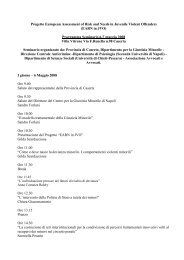Scarica il documento - Dipartimento per la Giustizia Minorile
Scarica il documento - Dipartimento per la Giustizia Minorile
Scarica il documento - Dipartimento per la Giustizia Minorile
You also want an ePaper? Increase the reach of your titles
YUMPU automatically turns print PDFs into web optimized ePapers that Google loves.
How does MI look like in practice?<br />
speciale<br />
Mi consists of a series of talks (called interviews, which can be a bit confusing term)<br />
that start in a rather non-directive way. at this stage the counsellor (e.g. a psychologist or<br />
social worker etc.) mainly makes use of the principles and the basic or micro sk<strong>il</strong>ls of Mi.<br />
so in this phase the counsellor gives attention, asks open-ended questions and listens actively<br />
and reflectively. the contents of the talks are in this stage rather wide. if possible the<br />
counsellor is going to aim more and more but carefully at exploring the ambivalence of the<br />
client. one of the important rules of thumb is: never go faster than the client allows you.<br />
When the counsellor gauges that the client is ‘ready’ for the next stage - called constructive<br />
confrontation - s/he starts to direct the talks towards exploring and resolving the<br />
ambivalence (i.e. no change or change) by using the the directive principles of Mi, namely<br />
selective reflection and the development of discrepancy.<br />
Finally counsellor and client together do a cost benefit analysis (or cost effectiveness<br />
procedure) aimed at action of the client to change his/her behaviour. during this procedure<br />
an inventory is made of the advantages and disadvantages of respectively no change or<br />
change. these advantages and disadvantages are discussed and weighed up against each<br />
other. the results of this procedure are used to try and resolve the ambivalence.<br />
The adaptation of MI for the benefit of Youth Justice in the Nether<strong>la</strong>nds<br />
some years ago when participating in an international project called Joint education<br />
& training (Jet) we became aware of Mi. almost immediately it seemed worthwh<strong>il</strong>e to<br />
explore whether Mi could be successfully included within the resettlement approaches for<br />
juven<strong>il</strong>e (ex-) offenders in the Nether<strong>la</strong>nds and which adaptations would be necessary.<br />
From 2001 to 2003 a number of ex<strong>per</strong>imental courses were held aimed at the application<br />
of Mi for juven<strong>il</strong>e (ex-) offenders. summarizing briefly, the main ex<strong>per</strong>ience was<br />
that Mi can provide an excellent contribution to the resettlement programmes we use. to<br />
contribute to the ultimate goal, stop re-offending, Mi is used as a vehicle to help the juven<strong>il</strong>e<br />
to become motivated for relevant activities such as stop using soft drugs, go to school,<br />
finish school, complete a vocational training, work, apply for a job, find suitable housing,<br />
etcetera.<br />
Furtherly we have ex<strong>per</strong>ienced 1) that the Cycle of Change is recognized as being<br />
very realistic and applicable in the work we do with young (ex-) offenders and 2) that the<br />
principles and the basic or micro sk<strong>il</strong>ls of Mi can be used successfully in all kinds of guidance<br />
activities of juven<strong>il</strong>es.<br />
in these ex<strong>per</strong>imental courses we have developed a training module and learning<br />
materials specifically focused on juven<strong>il</strong>e (ex-) offenders, e.g. exercises, readers, a demo<br />
dvd and a booklet.<br />
i have unt<strong>il</strong> now given approximately 25 training courses Mi to executive workers in<br />
juven<strong>il</strong>e instititions, youth probation services etc. in the Nether<strong>la</strong>nds, two training courses<br />
in united Kingdom and two in italy. i am st<strong>il</strong>l very positive about the usefulness of this methodology<br />
for the work we do with our target group.<br />
167





